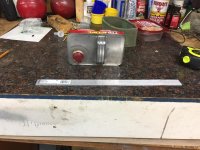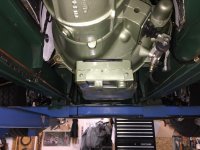D
Deleted member 21878
Guest
Guest
Offline
you all have probably come up with your own system but in case this could help someone... well...
i have oil leaking from the vent hole in the bell housing. it could be thru the new rear main seal i installed or it could be from the rebuilt gearbox. i don't know. but there are three things i do know.
1) it is leaking thru that hole
2) it is not likely to stop on it's own
3) i do not plan to pull the engine to figure out what it is or fix it at this time.
So i thought back to what i did with my old TD since it had the same issue. i made an oil catcher. it does not stop the oil but it does allow me to control when it hits the ground.. or a bowl in my case.
this is made from a simple top to a gas can. it was cut and turned upside down to catch the oil as it drips. it is not usually a lot of oil. i probably drained it maybe once a month on the TD. see below


as you can see, i go under about once a month and take off the top and drain it in to a bowl. then put the cap back on. i had already cut this top out for some reason (i rarely throw things away obviously) and so i ended up adding to the height of it in the back. i am not sure i want to leave it this height since it sticks down about an inch below the frame. not a big problem to cut it and move it up a little. it really does not need to be very deep. mine is about 2" in the back and 1" is probably plenty, as long as the front side does not get too shallow. it is held on with the aluminum bar that i cut in half and bent around the bottom. it is bolted to the bell housing via the two bottom bolts.
all made from junk i had laying around... so cost? just my time.
i have oil leaking from the vent hole in the bell housing. it could be thru the new rear main seal i installed or it could be from the rebuilt gearbox. i don't know. but there are three things i do know.
1) it is leaking thru that hole
2) it is not likely to stop on it's own
3) i do not plan to pull the engine to figure out what it is or fix it at this time.
So i thought back to what i did with my old TD since it had the same issue. i made an oil catcher. it does not stop the oil but it does allow me to control when it hits the ground.. or a bowl in my case.
this is made from a simple top to a gas can. it was cut and turned upside down to catch the oil as it drips. it is not usually a lot of oil. i probably drained it maybe once a month on the TD. see below


as you can see, i go under about once a month and take off the top and drain it in to a bowl. then put the cap back on. i had already cut this top out for some reason (i rarely throw things away obviously) and so i ended up adding to the height of it in the back. i am not sure i want to leave it this height since it sticks down about an inch below the frame. not a big problem to cut it and move it up a little. it really does not need to be very deep. mine is about 2" in the back and 1" is probably plenty, as long as the front side does not get too shallow. it is held on with the aluminum bar that i cut in half and bent around the bottom. it is bolted to the bell housing via the two bottom bolts.
all made from junk i had laying around... so cost? just my time.
Last edited by a moderator:

 Hi Guest!
Hi Guest!

 smilie in place of the real @
smilie in place of the real @
 Pretty Please - add it to our Events forum(s) and add to the calendar! >>
Pretty Please - add it to our Events forum(s) and add to the calendar! >> 


 Gonzo
Gonzo